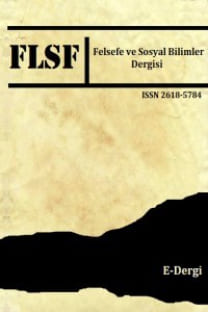HOMO EX MACHINA’DAN HOMO EX LABES’E POSTMODERNİST BULANIKLIK
Metnin amacı moderniteyle ortaya çıkan çalışma ve üretme kaygısının değiştirdiği ve mekanikleştirdiği insan algısını eleştirmeye dayanmaktadır. “Deus ex machina”nın müdahaleci ve olayları kontrol altına alan tutumu toplumsal yapılanma ve egemenle birlikte ele alınırken bu durumun insanı “homo ex machina”ya dönüştürerek mekanik ve tek tipçi bir tavra büründürmesi kaçınılmaz görülmektedir. Modernizmin bu tavrı postmodernite ile kırılgan ve parçalanmış bir belirsizliğe dönüşürken, tekinsizlik ve tiksinti veren bir dehşet noktası karşımıza çıkmaktadır. Bu “homo ex label”dir, kendi bulanıklığının farkında olan kent ve kent-dışılık noktasında arada kalmış olan ve enfeksiyonlu bireye bir vurgudur. “Homo ex machina” konumundaki kentli persona ve hem bulaşmaya yatkın hem de enfeksiyonlu “homo ex label” arasındaki tutum farkı incelenecektir. Bir yanda itaatkar, çalışkan, üreten ve kendisi de yeniden üretilebilir bir çark olarak yükselen kentli persona bulunmaktayken; diğer yanda zaten dışlanmış olan bir yabancı durumundaki bulanık pharmakon’un durumu konumlanmaktadır. Mevcut metin bulanıklık, tiksindiricilik, kent ve doğa durumu üzerinden ortaya konan bir tartışma çabasıdır.
Anahtar Kelimeler:
homo ex machina, homo ex label, bulanıklık, kentli, enfeksiyon
FROM HOMO EX MACHINA TO HOMO EX LABES: POSTMODERNIST TURBIDITY
The purpose of the text is based on criticizing the human perception that has been changed and mechanized by the anxiety of work and production that emerged with modernity. While the interventionist and controlling attitude of the "Deus ex machina" is handled together with the social structuring and the sovereign, this situation will inevitably turn people into a "homo ex machina" and turn them into a mechanistic and uniform attitude. While this attitude of modernism turns into a fragile and fragmented uncertainty with postmodernity, a point of dismay and disgust emerges. This is the "homo ex label", an emphasis on the infected individual who is in between at the point of urban and extra-urbanism, who is aware of his turbidity. The difference in attitude between the urban persona in the position of "Homo ex machina" and "homo ex label" susceptible both to contamination and infection will be examined. On the one hand, there is the urban persona who is obedient, hardworking, productive, and himself rising as a reproducible wheel; on the other hand, the situation of the fuzzy pharmakon in the case of an outsider who has already been excluded is located. The present text is a discussion effort based on blur, disgust, city, and nature.
Keywords:
turbidity, urbanite, infection, homo ex label, homo ex machina,
___
- Arppe, T. (2009). Sorcerer’s Apprencites and the ‘Will to Figuration’: The Ambiguous Heritage of the Collège de Sociologie, Theory, Culture & Society, 26.
- Artaud, A. (1993). Tiyatro ve İkizi, (çev. Bahadır Gülmez), İstanbul: YKY.
- Bataille, G. (1995). Encyclopedia Acephalica. London: Atlas Press.
- Bataille, G. (2001).The Unfinished System of Nonknowledge, (trans. Michelle Kendall – Stuart Kendall). University of Minnesota Press.
- Baudrillard, J. (2005). Baştan Çıkarma Üzerine, (çev. Ayşegül Sönmezay). İstanbul: Ayrıntı.
- Bauman, Z. (2013). Postmodernizm ve Hoşnutsuzlukları, (çev. İ. Türkmen). İstanbul: Ayrıntı.
- Benjamin, W. (1983) Das Passagen-Werk, Pasajlar, (çev. A. Cemal). İstanbul: YKY.
- Berman, M. (1983) All That Is Solid Melts into Air: The Experience of Modernity, Katı Olan Her Şey Buharlaşıyor: Modernite Deneyimi, (çev. Ü. Altuğ, B. Peker). İletişim Yayıncılık, İstanbul
- Berman, M. (2001). Katı Olan Her şey Buharlaşıyor, (çev. Ümit Altuğ – Bülent Peker). İstanbul: İletişim.
- Derrida, J. (2012). Platon’un Eczanesi, (çev. Zeynep Direk). İstanbul: Pinhan.
- Diken, B. (1997). Richard Sennett, Kamusal Yaşam ve Kent, Birikim Dergisi, 97, 70-78.
- Eco, U. (2009). Çirkinliğin Tarihi, (çev. Ali Cevat Akkoyunlu). İstanbul: Doğan Kitap.
- Hegel, (2001).The Phenomenology of Mind, (trans. J. B. Baillie), Blackmask.
- Heidegger, (2007). Sanat Eserinin Kökeni, (çev. Fatih Tepebaşlı), Ankara: De Ki Basım Yayım.
- Heidegger, M. (2008). Varlık ve Zaman, (çev. Kaan H. Ökten). İstanbul: Agora.
- Heidegger, M. (2015). Metafiziğe Giriş, (çev. Mesut Keskin). İstanbul: Avesta.
- Işık, O. (1993). Modernizm Kenti/Postmodernizm Kenti, Birikim Dergisi, 53, 27-34.
- Jung, C.G. (2006). Analitik Psikoloji, (çev. Ender Gürol). İstanbul: Payel Yayınları.
- Jung, C.G. (2013). İnsan Ruhuna Yöneliş, (çev. Engin Büyükinal). Ankara: Say.
- Kristeva, J. (1988) Etrangers ànous-mêmes, Strangers to Ourselves, (çev. L. S. Roudiez) (1991) Harvester Wheatsheaf , Hemel Hempstead.
- Kristeva, J. (2009). Korkunun Güçleri - İğrençlik Üzerine Bir Deneme, (çev. Nilgün Tutal). İstanbul: Ayrıntı.
- Marcuse, R. & Kepmen P. (2000). Global Cities, Massachussets: Blackwell.
- Marx, K. (2014). 1844 El Yazmaları, (çev. Murat Belge). İstanbul: Birikim.
- Platon, (2000). Sofist, (çev. Cenap Karakaya). İstanbul: Sosyal.
- Platon, (2001). Phaidon, (çev. Hamdi Ragıp Atademir). İstanbul: Sosyal.
- Platon, (2012). Menon (Erdem Üstüne), (çev. Adnan Cemgil). Diyaloglar. İstanbul: Remzi.
- Simmel, G. (1903) Die Grosstädte und das Geistesleben, Metropol ve Tinsel Hayat, çev. N. Kalaycı, (2003), Modern Kültürde Çatışma, İstanbul: İletişim, 85-102.
- Su, S. (1995). Postmodern Dönem Semptomları. Birikim Dergisi, 74, 46-49.
- Tekeli, İ. (1995). Modernite Aşılırken Siyaset. Ankara: İmge.
- Yayın Aralığı: Yılda 2 Sayı
- Başlangıç: 2006
- Yayıncı: Hamdi BRAVO
Sayıdaki Diğer Makaleler
QUALIA’YI TİNSEL NİTELİKLER OLMADAN AÇIKLAYABİLİR MİYİZ?
IBN SİNA’NIN BİR BİLİM OLARAK METAFİZİK ANLAYIŞI
HASSAS AYAR ARGÜMANI VE YAPAY ZEKA İTİRAZI
SEVGİ ANLAYIŞINDA DÜŞÜNSEL AYRIMLAR: MEVLANA İLE KONFUÇYÜS ÖĞRETİLERİNDE İNSANLIK VE AHLAK İLİŞKİSİ
PLATON’DA YASALAR VE YASALARIN KAYNAĞI
NEOLİBERALİZMİN POLİTİK TAHAYYÜLÜ: SERBEST PİYASANIN “BÜYÜSÜ”
ROUSSEAU’NUN SİYASET DÜŞÜNCESİNDE DOĞA DURUMUNUN MODERN DEĞERİ
PERFORMATİFLİĞİ YENİDEN DÜŞÜNMEK: DESTRÜKTİF PLASTİKİYET
HÜMANİZMİN SINIRINDA: PICO’NUN “YERSİZ” İNSANINA HEIDEGGER’İN DASEIN’I “YURT” OLABİLİR Mİ?
